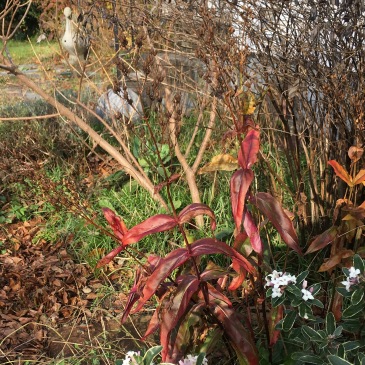Originally published in East Bay RI newspapers January 31, 2018.
I worry sometimes I’ll forget everything I ever learned if I don’t practice every day. Like losing muscle after a prolonged stint on the couch with a dog on my feet. (Happens to me every winter.) In my new role working at a public library, practice makes perfect. Policies and procedures will become ingrained with heavy use. I need to know the rules like I know the path to my shed. But I can’t help worrying that learning those things will displace everything I know about gardening.
Back when I lived in Seattle I worked at a large bookstore and knew about 300 people by name. I’m not good with names. They fly right out of my ear if I’m the least bit distracted. I used to quiz myself whenever I visited different departments, ate lunch in the break room, or passed a coworker on the street. Name to face, name to face, name to face. Distributing paychecks (one of the best jobs ever) without having to ask for a name was a point of pride. After I moved home to Rhode Island and started gardening the shelves in my brain that held those names were almost instantly repopulated with plants. — Which makes visits to my old stomping grounds extremely awkward. I recognize faces, most, but their names are buried in the garden.
Now that I’m not using them every day will my plants’ names become buried too? Not if I can help it. But I’ve noticed a worrisome lag. That I’ll look at familiar foliage or flowers and get the spinning pinwheel while my brain database is searched. I’ll have to build more shelves or move them closer to the light. I’ll have to keep quizzing myself. That’s the trick. Every day, every glance out the kitchen window, every drive down the road and walk around the neighborhood I’ll have to put name to face, name to foliage, name to flower (this time of year, name to twig and bark) and greet them like friends.
At least plant names offer clues for retrieval from the vault, much easier than trying to associate a person to the name Mary and distinguish her from a Barbara with the same haircut. Plant names were chosen specifically (no pun intended) to describe their owner. Thanks to Carl Linnaeus, Botanical Latin follows a binomial system similar to ours, but last name first. Genus is a general grouping of common genetics, and species identifies individuals usually with a descriptor of a particular characteristic or origin. Salix (Latin for willow) rosmarinifolia has foliage that resembles rosemary. Itea (the Greek name for willow, a lookalike) virginica is native to Virginia (and the Eastern U.S.). Rosa (we know this one) rugosa has rough and wrinkled leaves. Associations come easily with familiarity, the use of a good dictionary like “The Hamlyn Guide to Plant Names” by Allen J. Coombes, and constant quizzing.
 Latin names are universal (though taxonomists like to change things up as they learn more about genetics) whereas common names are variable by country, language, region, and person. Honesty, also known as money plant, also known as silver dollar is Lunaria (like the moon) annua all over the world. But even the geek in me will acknowledge common names are sometimes easier to recall, certainly easier to pronounce. Love-in-a-mist (Nigella damascena) flowers look exactly like a Gothic novel. Love-in-a-puff (Cardiospermum halicacabum) has black seeds marked with a white heart tucked inside balloon pods. Their identity is obvious.
Latin names are universal (though taxonomists like to change things up as they learn more about genetics) whereas common names are variable by country, language, region, and person. Honesty, also known as money plant, also known as silver dollar is Lunaria (like the moon) annua all over the world. But even the geek in me will acknowledge common names are sometimes easier to recall, certainly easier to pronounce. Love-in-a-mist (Nigella damascena) flowers look exactly like a Gothic novel. Love-in-a-puff (Cardiospermum halicacabum) has black seeds marked with a white heart tucked inside balloon pods. Their identity is obvious.
Seed and plant catalogs have been arriving for weeks and I’ve been reading them cover to cover for mental calisthenics as well as shop-therapy. As for remembering how to garden, I probably shouldn’t worry. Muscle memory needs little cultivation to get things growing again.
I appreciate the crutch of name tags (for people too) but prefer to sort through an untidy record of purchases than look out at a graveyard of labels. How about you?







 And dewy mornings are turning our gardens into galleries of exquisite web art.
And dewy mornings are turning our gardens into galleries of exquisite web art.